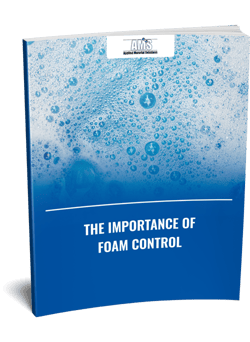Specialist Tips on Implementing Foam Control in Chemical Processing Environments
Wiki Article
Comprehending the Value of Foam Control in Industrial Processes
In commercial procedures, foam control is typically a neglected yet vital facet that directly influences functional effectiveness and product honesty. The existence of excessive foam can lead to substantial difficulties, including interfered with blending and lessened reaction kinetics, which may inevitably impact item high quality across different industries such as drugs and food production.
The Duty of Foam in Sector
Foam plays a considerable role in numerous industrial processes, affecting both effectiveness and product high quality. In sectors such as food and drink, pharmaceuticals, and petrochemicals, foam can offer both helpful and harmful functions. In the food industry, foam stablizing is crucial throughout processes like whipping cream or generating beer, where the high quality of foam straight impacts customer perception and product features.In chemical manufacturing, foam can serve as an obstacle, preventing the appropriate blending of reagents, which can result in insufficient responses and suboptimal yields. On the other hand, in procedures like flotation in mineral processing, foam is used to divide valuable minerals from waste material, boosting recovery rates.
Additionally, in wastewater therapy, foam formation can indicate the existence of natural issue, acting as an important specification for procedure surveillance. The ability to manage foam is necessary for keeping process stability and optimizing operational expenses. Recognizing the duty of foam in commercial applications allows operators and engineers to implement reliable foam administration strategies, guaranteeing that foam contributes favorably to overall process performance while lessening its possible drawbacks.
Common Challenges of Foam Development
Lots of markets encounter considerable challenges as a result of the unexpected formation of foam throughout different procedures. Foam can disrupt the efficiency of operations, causing increased downtime and greater functional costs. In fields such as drugs, food and drink, and wastewater therapy, foam can impede blending, lower item yield, and make complex separation procedures.In addition, foam can create security threats by blocking clear presence, which is important in environments where specific measurements and monitoring are required. The presence of foam can additionally cause tools damage, as excessive pressure build-up may happen in storage tanks and reactors.
In addition, the need for regular treatment to take care of foam can draw away sources and labor, eventually influencing efficiency. Ecological laws position one more difficulty, as too much foam can bring about non-compliance problems in effluent discharge, necessitating additional treatment processes.
Influence On Product Top Quality

In chemical manufacturing, foam can prevent response kinetics by restricting gas-liquid get in touch with, bring about incomplete reactions and reduced returns. This not just impacts the effectiveness of manufacturing but can likewise result in ineffective final result that do not meet regulatory criteria or consumer requirements.
In addition, in drugs, foam formation throughout solution procedures can introduce air bubbles right into delicate compounds, endangering drug efficacy and security. In enhancement, foam can trigger functional concerns such as overflow and equipment malfunctions, boosting downtime and upkeep costs, even more impacting item top quality and uniformity.
Strategies for Efficient Foam Control
Attending to the obstacles posed by foam is vital for maintaining product high quality throughout different commercial markets. Reliable foam control approaches are important to reduce the negative impacts of foam development, which can interrupt procedures and compromise product stability.One of the main techniques includes the browse around these guys selection and application of suitable antifoaming agents. These agents are designed to reduce surface stress and hinder bubble development, and their efficiency can vary based on the specific process problems. Normal tracking of foam levels is important to guarantee timely treatment, permitting drivers to apply antifoaming agents prior to foam comes to be a considerable problem.
Additionally, optimizing procedure specifications such as temperature and agitation can play a critical duty in foam administration. Decreasing agitation strength or changing feed rates can decrease foam generation. Carrying out mechanical foam control devices, such as foam breakers or defoamers, can additionally give efficient solutions for high-foaming applications.
Educating workers on foam management strategies and the importance of keeping ideal operating conditions better improves foam control initiatives. Foam Control. By utilizing a combination of these methods, sectors can successfully manage foam, making certain operational performance and preserving the top quality of their products
Future Trends in Foam Administration
Just how will developments in innovation form the future of foam management in industrial procedures? The assimilation of synthetic intelligence (AI) and artificial intelligence will reinvent foam control approaches, enabling real-time tracking and adaptive actions to foam development. These technologies can evaluate functional criteria and historical data to predict foam habits, enabling for preemptive actions that boost check my site procedure efficiency.Moreover, the development of sophisticated foam control agents, including bio-based and ecologically pleasant options, is getting grip. These advancements not only reduce foam however likewise line up with sustainability goals, decreasing the ecological footprint of commercial procedures.
Automation will certainly additionally play an essential duty, as automated foam control systems can enhance the dosage of defoamers based on page real-time measurements, minimizing waste and boosting performance.
Moreover, the fostering of IoT (Internet of Things) tools will certainly assist in seamless communication in between tools and foam control systems, making sure an alternative method to foam management. (Foam Control)
Verdict
Finally, efficient foam control is important for optimizing commercial processes across numerous markets. The challenges postured by foam development can considerably impact item quality and functional effectiveness. Implementing critical foam administration techniques, consisting of making use of antifoaming representatives and process optimization, mitigates these obstacles. As industries proceed to develop, recurring improvements in foam control technologies will certainly further boost productivity and sustainability, making certain compliance with ecological policies while keeping the stability of items.In the food industry, foam stabilization is critical during processes like whipping lotion or generating beer, where the quality of foam straight influences customer perception and product features.
Understanding the role of foam in industrial applications enables designers and drivers to execute efficient foam monitoring strategies, guaranteeing that foam adds favorably to total process performance while reducing its prospective downsides.
Normal monitoring of foam levels is important to make sure prompt treatment, permitting drivers to use antifoaming representatives prior to foam comes to be a substantial concern.
Implementing mechanical foam control devices, such as foam breakers or defoamers, can also provide effective solutions for high-foaming applications.
The integration of artificial intelligence (AI) and machine learning will revolutionize foam control approaches, making it possible for real-time surveillance and flexible actions to foam formation.
Report this wiki page